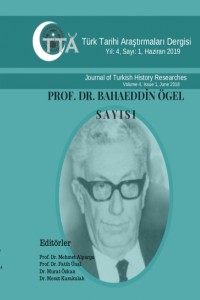Abstract
Türk tarihinin tarihsel süreci düşünüldüğünde üç ana ortak sanat
dönemini belirlemek mümkündür. Bunlardan ilki Bozkır kültür çağı olarak tabir ettiğimiz doğa insan ilişkisinin
üstün sanat anlayışını doğurduğu 10. Yüzyıla kadar olan süreçtir. İkincisi ise,
yeni bir din ve medeniyetin etkisi altında bilim ve sanatta günden güne etkisi
artan Arapça ve Farsçanın kültür dairesine girildiği İslâmi dönemdir.
Son dönemi ise Türklerin toplumsal, iktisadî ve siyasî hayatlarının yanı sıra
kültürel hayatlarında da hızlı değişimin yaşandığı milli uyanış devri
olarak tasnif edebilmek mümkündür. Bu çalışma Türk dünyasının tamamında ortak bir sanat anlayışının mümkün olup
olamayacağı sorunsalı üzerinedir.
References
- ABDÜRREŞİDOV, Zeynelabidin, İsmail Gaspirinski ve Türkistan’da Cedidçilik. Taşkent, 2008. BASKICI, Murat, “Evcilleştirme Tarihine Kısa Bir Bakış”, Ankara Üniversitesi SBF Dergisi, Cilt 53, Sayı 1, 1998, ss. 73-94. DEVLET, Nadir, İsmail Gaspıralı Unutturulan Türkçü, İslamcı, Modernist, Başlık Yayınları, İstanbul 2011. ______, Rusya Türklerinin Mülli Mücadele Tarihi (1905- 1917), Ankara, Türk Tarih Kurumu Yayınları. Erken İç Asya Tarihi, Derleyen Denis Sinor, İletişim Yayınları, İstanbul 2002, ss. 61-167. GASPIRALI, İsmail Seçilmiş Eserleri:1 Roman ve Hikâyeleri, (Hzr Yavuz, Akpınar-Bayram Orak-Nazım Muradov, Ötüken Neşriyatı, İstanbul 2003. HARARİ, Yuval Noah, Hayvanlardan Tanrılara Sapiens İnsan Tüürnün Kısa Bir Tarihi, Çev. E. Genç, kollektif Yayınları, İstanbul 2015. ILGAR, İhsan, Rusya’da Birinci Müslüman Kongresi, Kültür Bakanlığı Yayınları, Ankara 1988. KÖPRÜLÜ, Mehmet Fuat, Türk Edebiyat Tarihi, Ötüken Yayınları, İstanbul 1980. McNeil, William H., Dünya Tarihi, Çev. A. Şenel, İmge Yayınları, Ankara 2004, TANPINAR, Ahmet Hamdi, XIX. Asır Türk Edebiyatı Tarihi, Yapı Kredi Yayınları, İstanbul 2006. TORAMAN, Ali, Arkeolojik Veriler Işığında Altaylarda At Koşumları ve Savaş Aletleri (İlk Zamanlardan IX. Yüzyıla Kadar), Erciyes Üniversitesi, Sosyal Bilimler Enstitüsü, Genel Türk Tarihi Bilim Dalı, Basılmamış Doktora tezi, 2018.
Abstract
Considering the historical process of Turkish history, it is possible
to identify three common main art periods. The first of these is the steppe
culture age. The relationship between nature and human gave birth to the
concept of art and the period lasted until the 10th century.
The second is the Islamic period, in
which Arabic and Persian entered the cultural circle under the influence of a
new religion and civilization. In the last period, it is possible to classify
it as a period of ‘national revival’, where rapid change is taking place in the
social, economic and political life of the Turks as well as in cultural life.
This study focuses on the question of whether a common understanding of art can
be possible throughout the Turkish world.
References
- ABDÜRREŞİDOV, Zeynelabidin, İsmail Gaspirinski ve Türkistan’da Cedidçilik. Taşkent, 2008. BASKICI, Murat, “Evcilleştirme Tarihine Kısa Bir Bakış”, Ankara Üniversitesi SBF Dergisi, Cilt 53, Sayı 1, 1998, ss. 73-94. DEVLET, Nadir, İsmail Gaspıralı Unutturulan Türkçü, İslamcı, Modernist, Başlık Yayınları, İstanbul 2011. ______, Rusya Türklerinin Mülli Mücadele Tarihi (1905- 1917), Ankara, Türk Tarih Kurumu Yayınları. Erken İç Asya Tarihi, Derleyen Denis Sinor, İletişim Yayınları, İstanbul 2002, ss. 61-167. GASPIRALI, İsmail Seçilmiş Eserleri:1 Roman ve Hikâyeleri, (Hzr Yavuz, Akpınar-Bayram Orak-Nazım Muradov, Ötüken Neşriyatı, İstanbul 2003. HARARİ, Yuval Noah, Hayvanlardan Tanrılara Sapiens İnsan Tüürnün Kısa Bir Tarihi, Çev. E. Genç, kollektif Yayınları, İstanbul 2015. ILGAR, İhsan, Rusya’da Birinci Müslüman Kongresi, Kültür Bakanlığı Yayınları, Ankara 1988. KÖPRÜLÜ, Mehmet Fuat, Türk Edebiyat Tarihi, Ötüken Yayınları, İstanbul 1980. McNeil, William H., Dünya Tarihi, Çev. A. Şenel, İmge Yayınları, Ankara 2004, TANPINAR, Ahmet Hamdi, XIX. Asır Türk Edebiyatı Tarihi, Yapı Kredi Yayınları, İstanbul 2006. TORAMAN, Ali, Arkeolojik Veriler Işığında Altaylarda At Koşumları ve Savaş Aletleri (İlk Zamanlardan IX. Yüzyıla Kadar), Erciyes Üniversitesi, Sosyal Bilimler Enstitüsü, Genel Türk Tarihi Bilim Dalı, Basılmamış Doktora tezi, 2018.
Details
| Primary Language | Turkish |
|---|---|
| Journal Section | Articles |
| Authors | |
| Publication Date | June 26, 2019 |
| Published in Issue | Year 2019 Volume: 4 Issue: 1 |


